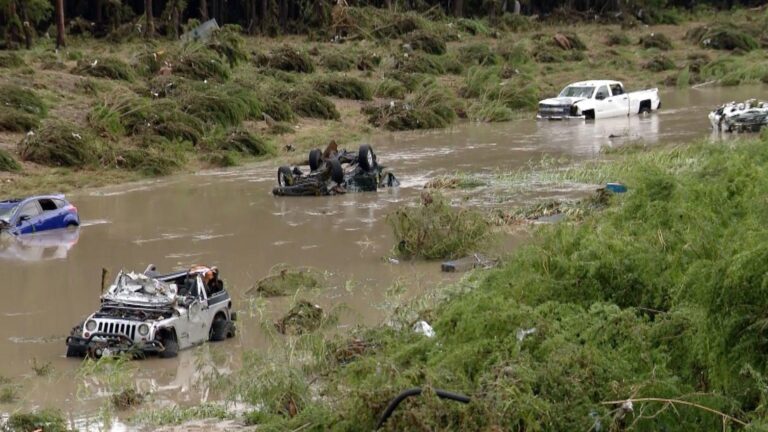San Antonio Flood Crisis: A Call for Enhanced Emergency Preparedness and Community Resilience
Recent catastrophic flooding in San Antonio has led to at least 15 vehicles being carried away by surging waters, tragically claiming eight lives and leaving six people missing, according to official reports. The sudden and intense flash floods inundated streets and residential areas, severely hampering rescue operations and raising urgent concerns for those still unaccounted for. Emergency teams remain actively engaged in search and recovery efforts as the community confronts the devastating aftermath and ongoing flood risks.
Critical Lessons from San Antonio’s Flood Disaster: Strengthening Emergency Response Systems
The unprecedented flooding event has starkly revealed significant vulnerabilities in San Antonio’s disaster management framework. Torrential rains unleashed rapid flash floods that overwhelmed existing infrastructure and emergency protocols, resulting in the loss of lives and vehicles. First responders encountered immense difficulties due to delayed alerts and fragmented communication channels, highlighting the pressing need for systemic improvements in disaster readiness.
Authorities and emergency management experts are advocating for comprehensive reforms focused on:
- Modernizing flood alert mechanisms to deliver instantaneous warnings to at-risk populations.
- Expanding specialized training for rescue personnel to better navigate complex flood scenarios.
- Reinforcing critical infrastructure such as stormwater drainage and designated evacuation corridors.
- Boosting public education initiatives to foster community-wide preparedness and safety awareness.
| Area of Focus | Current Challenges | Proposed Enhancements |
|---|---|---|
| Flood Alert Systems | Delayed and inconsistent warnings | Deploy AI-driven, automated real-time notifications |
| Rescue Coordination | Communication lapses during operations | Implement unified communication platforms for responders |
| Infrastructure | Outdated drainage and flood barriers | Upgrade and maintain resilient flood control structures |
| Community Engagement | Low participation in preparedness programs | Increase outreach through drills and educational campaigns |
Obstacles Confronting Rescue Teams Amidst Torrential Floodwaters
Rescue operations during the San Antonio floods were severely challenged by a combination of natural and logistical barriers. Swift currents, submerged debris, and compromised infrastructure created perilous conditions that endangered both victims and emergency personnel. Power outages disrupted communication networks, while poor visibility due to relentless rain complicated aerial and ground rescue missions.
Key impediments included:
- Rapidly fluctuating water levels: Necessitated constant tactical adjustments by rescue teams.
- Insufficient specialized equipment: Many traditional rescue vehicles and boats were ill-equipped for the extreme conditions.
- Limited human resources: Extended shifts and the scale of the disaster stretched personnel thin.
- Safety hazards: Navigating debris-laden waters increased the risk of accidents and injuries.
| Challenge | Effect on Rescue Efforts |
|---|---|
| Obstructive Flood Debris | Slowed response times and access to victims |
| Communication Interruptions | Disorganized and inefficient coordination |
| Equipment Shortcomings | Limited operational reach and effectiveness |
| Responder Fatigue | Decreased operational performance |
Evaluating the Effects of Severe Weather on Vehicle Safety and Community Readiness
The San Antonio flood incident, which swept away numerous vehicles and caused multiple fatalities, highlights the profound risks extreme weather poses to motorists and the broader community. Vehicles, regardless of their size or power, are highly susceptible to being overwhelmed by fast-moving floodwaters, often trapping occupants and complicating rescue efforts. The presence of debris and murky waters further obstructs emergency response, emphasizing the need for advancements in vehicle safety features tailored to hydrological hazards.
Equally important is the role of community preparedness in reducing casualties during such events. Effective strategies include:
- Real-time flood alert systems that inform drivers and residents promptly.
- Clear and practiced evacuation plans to facilitate orderly and safe departures from danger zones.
- Infrastructure enhancements such as elevated roadways and improved drainage to mitigate flood impact.
As climate change continues to increase the frequency and intensity of extreme weather, collaboration among city planners, vehicle manufacturers, and residents is vital to bolster resilience and safeguard lives.
| Factor | Impact on Vehicle Safety | Community Preparedness Approach |
|---|---|---|
| Sudden Floodwater Rise | Elevated risk of vehicles being swept away | Install early flood detection and alert systems |
| Reduced Visibility | Higher likelihood of accidents | Use illuminated signage and real-time alerts |
| Fragile Road Infrastructure | Potential road collapses and blockages | Invest in flood-resistant road construction |
Strategies to Advance Flood Warning Systems and Public Education
To lessen the destructive consequences of flash floods, it is imperative that local and federal agencies invest in cutting-edge flood warning technologies. Leveraging real-time hydrological monitoring combined with AI-based predictive analytics can significantly improve the accuracy and timeliness of alerts, especially in urban flood hotspots. Expanding communication channels—including SMS, mobile applications, and social media—ensures that critical warnings reach diverse populations swiftly.
Enhancing public education is equally crucial. Community-led workshops, multilingual flood preparedness materials, and regular evacuation drills empower residents to respond effectively during emergencies. The following table outlines essential components of a robust public awareness program:
| Program Component | Purpose | Implementation Method |
|---|---|---|
| Flood Safety Workshops | Inform residents about flood risks and protective actions | Collaborate with schools, local organizations, and faith groups |
| Evacuation Drills | Practice safe and orderly evacuation procedures | Conduct annual drills in flood-prone neighborhoods |
| Multilingual Alert Systems | Ensure accessibility for non-English speakers | Distribute alerts in multiple languages via digital platforms |
| Social Media Engagement | Provide timely updates and emergency information | Maintain active official social media channels |
Summary and Ongoing Response
The recent flooding in San Antonio has inflicted a profound human and material toll, with 15 vehicles lost to floodwaters, eight confirmed fatalities, and six individuals still missing. Emergency teams persist in their search and rescue operations amid continuing flood threats. Authorities urge residents to stay alert, avoid flooded areas, and adhere to safety advisories as investigations and recovery efforts proceed. Updates will be shared as new information emerges.




